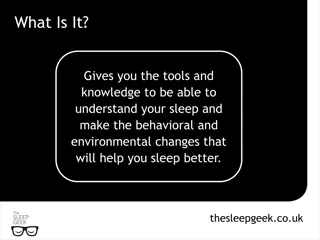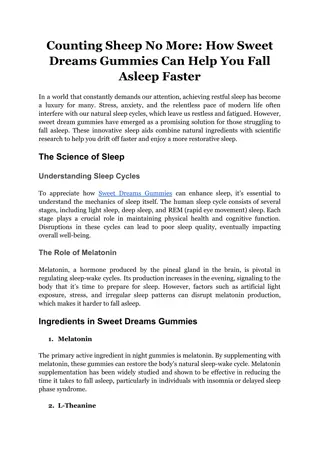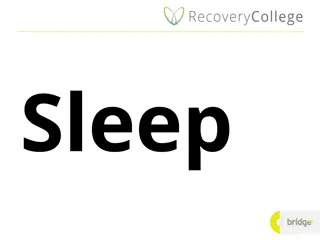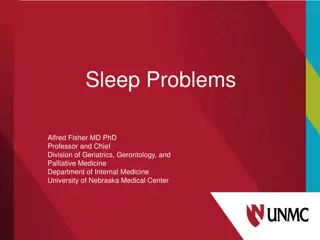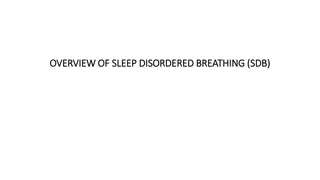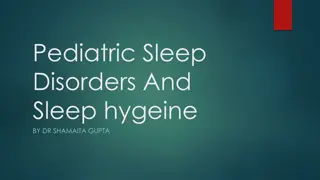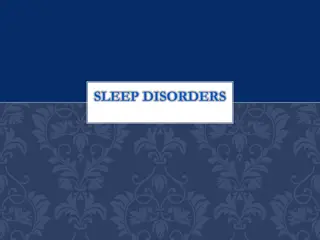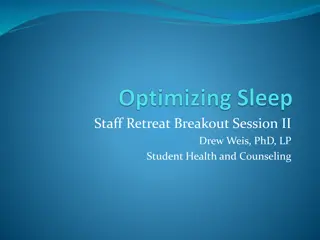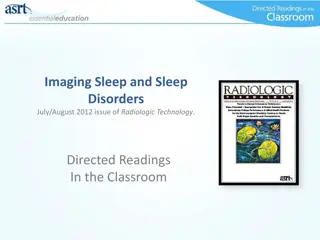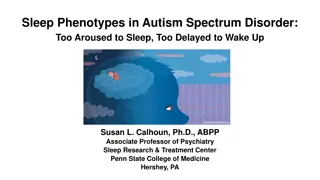Understanding and Treating Sleep Problems in Children with Autism
Sleep problems in children with autism are viewed as skill deficits that can be addressed through relevant skills teaching. Good sleep is crucial for children's overall well-being, as it affects mood, behavior, learning, and physical health. Lack of good sleep can lead to irritability, fatigue, unintentional injuries, difficulty following instructions, and engaging in problem behaviors. Addressing sleep issues is essential to prevent long-term consequences such as obesity, behavioral problems, and emotional issues. The prevalence of sleep problems in children with autism is high and persistent, requiring timely intervention.
Download Presentation

Please find below an Image/Link to download the presentation.
The content on the website is provided AS IS for your information and personal use only. It may not be sold, licensed, or shared on other websites without obtaining consent from the author. Download presentation by click this link. If you encounter any issues during the download, it is possible that the publisher has removed the file from their server.
E N D
Presentation Transcript
. Understanding and Treating Sleep Problems of Children with Autism Gregory P. Hanley. Ph.D., BCBA-D DataFinch November, 2014
Important assumption of Behavior Analysis: Sleep problems are viewed as skill deficits which can be addressed by teaching relevant skills
Important assumption of Behavior Analysis: Autism is not a life sentence of poor sleep and tired days
Good Sleep falling asleep quickly staying asleep through the night rising without much trouble each morning not feeling drowsy during the day
Why is Good Sleep Important? Good sleep is restorative; without it, children are: more irritable more easily fatigued more likely to suffer from unintentional injury less likely to follow instructions less likely to learn academic concepts more likely to engage in problem behavior (meltdowns, self-injury, aggression, stereotypy)
Without good sleep, people with autism may be more likely to engage in stereotypy 16 Number of Hours Slept each Night Mean Baseline Session Rate of Stereotypy 14 r = -.484, p < .05 12 10 8 6 4 2 Jack 0 5 10 15 20 Days
Why is Good Sleep Important? Persistent sleep problems in childhood are also associated with: childhood and adult obesity adolescent behavioral and emotional problems anxiety in adulthood sleep problems through adulthood
Why is Good Sleep Important? Children s sleep problems can lead to: Maternal malaise and depression Parental sleep problems Erosion of the parent s relationship with each other and with their children
How Prevalent are Sleep Problems? Sleep problems are prevalent: 35 - 50% of young children 63 - 73% of children diagnosed with autism Sleep problems are persistent they do not typically remit with time
Why So Prevalent? Clash between our ancestral history (encoded in our genes) and existing cultural practices we are built to sleep in a particular context but we are expected to sleep in a very different context
Treatment Options? Parents are likely to consult with pediatricians despite only 5 hr of training on average
Treatment Options? 81% of children s visits to pediatricians, psychiatrists, or family physicians for sleep problems result in a prescription for a medication despite no FDA approval, no medication labeled for pediatric insomnia, no (or inconsistent) efficacy signal in literature
Baseline Behavioral Intervention 0 mg 0 mg 0 ml Melatonin: 3 mg Clonidine: 0.1 mg Hydroxyzine: 4 ml 07:00 pm Ideal sleep zone Asleep Nap Goal bid goodnight time (09:00 pm) 09:00 pm 11:00 pm 01:00 am 03:00 am Time 05:00 am 07:00 am Goal wake time (08:00 am) 09:00 am Alice 11:00 am 5 10 15 20 25 30 35 40 45 50 55 60 65 70 75 80 Nights
Treatment Options? Behavioral solutions are recommended 22% of time (Stojanovski et al., 2007) but the solutions are relatively weak antecedent- oriented approaches (e.g., positiveroutines prior to bed) or not behavioral at all (candles and lotion)
Common Sleep Problems Nighttime routine noncompliance Sleep-interfering behavior Delayed sleep onset Night awakenings Early awakenings
Assumptions Regarding Sleep Behavioral quietude /Falling asleep are the behaviors of interest Can be influenced by past and present events in one s sleeping environment can be motivated (or demotivated) can become reliant on environmental cues can be affected by other reinforcers for other behaviors available at night
Looking at falling asleep. through the lens of a contingency Conduct a contingency analysis: EO + SD R Sr That which is known: Reinforcer (Sr) for falling asleep is sleeping That which is unknown: Everything else!
Looking at sleep. through the lens of a contingency EO + SD Falling Asleep Sleep What alters the value of sleep as a reinforcer?
Looking at sleep. through the lens of a contingency EO + SD Falling Asleep Sleep What signals that the reinforcer is available (and prepares the body to consume the reinforcer), and are those signals available when the child wakes up multiple times each night?
Looking at sleep. through the lens of a contingency EO + SD Interfering behaviors Sr What other behaviors are occurring before and after the bid good night that are incompatible with falling asleep (i.e., that do not allow for behavioral quietude)?
Looking at sleep. through the lens of a contingency EO + SD Interfering behaviors Sr What reinforcers are available for behaviors that are incompatible with falling asleep?
Looking at sleep. through the lens of a contingency EO + SD Incompatible behaviors Sr What alters the value of these other reinforcers for behaviors that are incompatible with falling asleep?
Looking at sleep. through the lens of a contingency EO + SD Incompatible behaviors Sr What signals that these other reinforcers are available?
How do we assess and treat children s sleep problem? Through a general understanding of the common factors that influence good sleep and sleep problems Using an open-ended indirect assessment to identify the personal factors influencing the sleep problem SATT (Sleep Assessment and Treatment Tool) By encouraging parents to develop the intervention with us we support parents in their implementation of the assessment- based treatment via phone calls and weekly visits.
A typical case example Ray 4-year-old-boy with Autism Hyperactive Parents tried multiple medications for sleep problems
Baseline Treatment 180 Clonidine 0.10 mg Sleep Onset Delay (min) 160 Melatonin 1-3 mg 140 120 Diary 100 Video 80 60 Appropriate Range of Sleep Onset Delay 40 Illness 20 0 120 Clonidine 0.10 mg Interfering Behavior (min) 100 80 Melatonin 1-3 mg 60 40 20 Illness 0 400 Night/Early Waking (min) Clonidine 0.10 mg 350 300 Melatonin 1-3 mg 250 200 150 Illness 100 50 0 14 Clonidine 0.10 mg 12 Total Sleep (hr) 10 8 Illness 6 Goal Range of Sleep 4 Melatonin 1-3 mg Naps 2 Ray 0 5 10 15 20 25 30 35 40 45 50 55 60 65 70 75 80 85 90 95 100 Nights
Baseline Treatment 180 Clonidine 0.10 mg Sleep Onset Delay (min) 160 Melatonin 1-3 mg 140 120 Diary 100 Video 80 60 Appropriate Range of Sleep Onset Delay 40 Illness 20 0 120 Clonidine 0.10 mg Interfering Behavior (min) 100 80 Melatonin 1-3 mg 60 40 20 Illness 0 400 Night/Early Waking (min) Clonidine 0.10 mg 350 300 Melatonin 1-3 mg 250 200 150 Illness 100 50 0 14 Clonidine 0.10 mg 12 Total Sleep (hr) 10 8 Illness 6 Goal Range of Sleep 4 Melatonin 1-3 mg Naps 2 Ray 0 5 10 15 20 25 30 35 40 45 50 55 60 65 70 75 80 85 90 95 100 Nights
Baseline Treatment 180 Clonidine 0.10 mg Sleep Onset Delay (min) 160 Melatonin 1-3 mg 140 120 Diary 100 Video 80 60 Appropriate Range of Sleep Onset Delay 40 Illness 20 0 120 Clonidine 0.10 mg Interfering Behavior (min) 100 80 Melatonin 1-3 mg 60 40 20 Illness 0 400 Night/Early Waking (min) Clonidine 0.10 mg 350 300 Melatonin 1-3 mg 250 200 150 Illness 100 50 0 14 Clonidine 0.10 mg 12 Total Sleep (hr) 10 8 Illness 6 Goal Range of Sleep 4 Melatonin 1-3 mg Naps 2 Ray 0 5 10 15 20 25 30 35 40 45 50 55 60 65 70 75 80 85 90 95 100 Nights
Baseline Treatment 180 Clonidine 0.10 mg Sleep Onset Delay (min) 160 Melatonin 1-3 mg 140 120 Diary 100 Video 80 60 Appropriate Range of Sleep Onset Delay 40 Illness 20 0 120 Clonidine 0.10 mg Interfering Behavior (min) 100 80 Melatonin 1-3 mg 60 40 20 Illness 0 400 Night/Early Waking (min) Clonidine 0.10 mg 350 300 Melatonin 1-3 mg 250 200 150 Illness 100 50 0 14 Clonidine 0.10 mg 12 Total Sleep (hr) 10 8 Illness 6 Goal Range of Sleep 4 Melatonin 1-3 mg Naps 2 Ray 0 5 10 15 20 25 30 35 40 45 50 55 60 65 70 75 80 85 90 95 100 Nights
Baseline Treatment 180 Clonidine 0.10 mg Sleep Onset Delay (min) 160 Melatonin 1-3 mg 140 120 Diary 100 Video 80 60 Appropriate Range of Sleep Onset Delay 40 Illness 20 0 120 Clonidine 0.10 mg Interfering Behavior (min) 100 80 Melatonin 1-3 mg 60 40 20 Illness 0 400 Night/Early Waking (min) Clonidine 0.10 mg 350 300 Melatonin 1-3 mg 250 200 150 Illness 100 50 0 14 Clonidine 0.10 mg 12 Total Sleep (hr) 10 8 Illness 6 Goal Range of Sleep 4 Melatonin 1-3 mg Naps 2 Ray 0 5 10 15 20 25 30 35 40 45 50 55 60 65 70 75 80 85 90 95 100 Nights
Social Acceptability Survey (Parents) Table 1 Average (Range) Questions Walter Andy Lou 1.Acceptability of assessment procedures 7 6 7 6.7 (6-7) 2. Acceptability of treatment 7 6 7 6.7 (6-7) 3. Improvement in sleep 7 7 7 7 4. Consultation was helpful 7 6 7 6.7 (6-7) Note: Likert scale: 1 to 7. 1 (not acceptable, not satisfied, not helpful), 7 (highly acceptable, highly satisfied, highly helpful)
Step 1: Develop Ideal Sleep Schedule Step 2: Routinize Nighttime Routine Step 3: Optimize Bedroom Conditions Step 4: Regularize Sleep Dependencies Step 5: Address Sleep Interfering Behavior
Step 1: Develop Optimal Sleep Schedule Recognize of age-appropriate sleep amounts Recognize importance of current sleep phase and forbidden zones Recognize universal tendency to go to bed later and wake up later
Age-Based Sleep Averages: Age 2 3 4 5 6 9 12 15 18 Total Sleep 11 hrs 30 min 9.5 hours 11 hrs 15 min 10 hours 11 hrs 10 hrs 45 min 10 hrs 30 min 10 hrs 9 hrs 45 min 9 hrs 15 min 9 hrs Night Sleep # Naps 1 (2 hrs) 1 (1hr15min) 0-1 10 -11 hours Adapted from: Solve Your Child's Sleep Problems, Richard Ferber, Simon & Schuster, 2006
Sleep Scheduling Cautions: Difficulty falling asleep, staying asleep, or complying with nighttime routines may occur if child is expected to be in bed too long Difficulty waking up or day time tiredness may be related to child being in bed for too short of a time Implication: Select the right sleep total for child
When should the bedtime be scheduled? Alert Sleepy Night Day Night Adapted from: Solve Your Child's Sleep Problems, Richard Ferber, Simon & Schuster, 2006
When should the bedtime be scheduled? Midday Dip in Alertness Forbidden Zone Alert Sleepy Night Day Night Adapted from: Solve Your Child's Sleep Problems, Richard Ferber, Simon & Schuster, 2006
When should the bedtime be scheduled? Caution Putting children to bed during the Forbidden Zone will increase the likelihood of nighttime routine noncompliance, sleep onset delays and sleep interfering behavior
When should the bedtime be scheduled? We have a tendency to go to bed later and wake up later because of our 24.2 hr clock Artificial light and nighttime activity availability leads to a 25-hour clock
Copied from: National Institute of Health (NIH) Sleep and Sleep Disorders Teachers Guide
When should the bedtime be scheduled? At the beginning of sleep treatment: set the start of the sleep routine slightly later than when the child fell asleep the previous night Then gradually transition sleep phase earlier if child falls asleep within 15 min move bedtime 15 min earlier next night until desired bedtime is achieved (Piazza et al., 1991)
Extreme Sleep Phase Shift? Consideration Try chronotherapy if sleep phase is more than 4 hours past desirable sleep time: Move sleep and awake times forward by 1 to 2 hours each night (larger leaps can be made with older children)
Step 2: Routinize Nighttime Routine Develop a nighttime routine that occasions behavioral quietude Try to implement it consistently across nights
Step 2: Routinize Nighttime Routine Some emphases prior to bid goodnight Activities progress from active to passive Arrange choices on picture schedule Make gradual changes in fun factor avoid rich to barren context transition Exercise/baths earlier in routine Ambient light gets progressively dimmer Light snacks without caffeine
Step 3: Optimize Bedroom Conditions Cooler temperature Indirect lighting only Non-undulating noise Best toys/preferred activities not visible
Nighttime Noncompliance Considerations Tendency to not follow instructions or resist guidance to, for example, put on PJs, brush teeth, or get in bed Solutions: Start routine just prior to natural sleep phase Promote instruction following during the day See steps on handout (e.g., name game, follow through, etc.)
BL1 BL2 100 U = 0, p < .05 Precursor = Responding effectively to one s name = stopping activity, looking at teacher, saying, Yes, and waiting until teacher says something. U = 11, p > .05 M % Precursors 80 Individual Children Beaulieu et al., (2013, JABA) 60 40 20 0 100 U = 12, p > .05 U = 4.5, p < .05 M % Compliance 80 60 40 20 0 Control Experimental Control Experimental Group
BL1 BL2 100 U = 0, p < .05 Precursor = Responding effectively to one s name = stopping activity, looking at teacher, saying, Yes, and waiting until teacher says something. U = 11, p > .05 M % Precursors 80 Individual Children 60 40 20 0 100 U = 12, p > .05 U = 4.5, p < .05 M % Compliance 80 60 Compliance = completing an instruction within 6 s 40 20 0 Control Experimental Control Experimental Group






